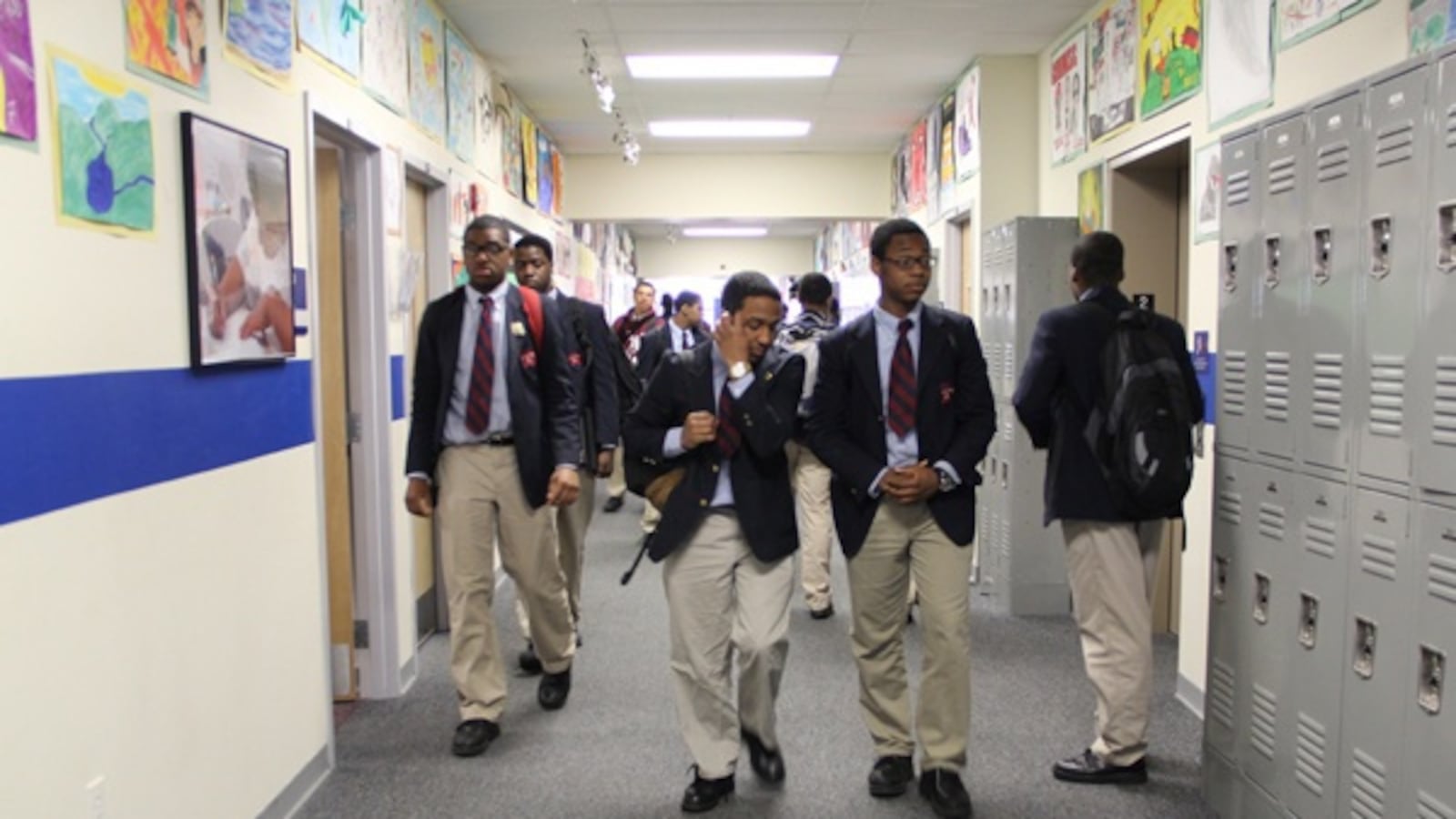This article was originally published in The Notebook. In August 2020, The Notebook became Chalkbeat Philadelphia.
Sixteen-year-old boys aren’t typically thought of as quiet observers of the world around them.
But that’s exactly what the students in Carly Ackerman’s 10th-grade composition class at Boys’ Latin Charter High School in West Philadelphia are learning to become.
"Ethnography is basically the observation of an area," said 16-year-old Marcus Smalls, a sophomore at Boys’ Latin, during a recent presentation to his class. "You’re observing people, how they act, and the tone of the area."
Despite the the School District’s painful financial woes — which have also hit charter schools hard this year — teachers across the city are still finding innovative ways to help students learn.
Smalls, a slight young man with a wispy beard and quick smile, said that until recently, he only paid attention to his surroundings when something bad was about to happen. Despite living in West Philadelphia his whole life, Smalls says he’d never been to city landmarks like Reading Terminal Market.
That is, until Ackerman introduced her ethnography unit last month, sending her students out of the classroom and into the city.
"When I walked in [to Reading Terminal], like a huge wind of heat hit my face, because it’s so much people in there," said Smalls. "It just went on and on and on with different places where you can eat. I almost felt like a kid in a candy store."
Ritzy Rittenhouse Square, the downtown malls at the Gallery and inside the Liberty Place skyscraper, and 30th Street Station were among the places Ackerman sent her students to conduct "ethnographic fieldwork." Her assignment for the boys? Check your preconceived notions at the door. Get over your discomfort at being in an unfamiliar place. Think of yourself as a real researcher, and learn to simply observe.
"I think here we really try to push this idea of having curiosity," said the 24-year-old Ackerman, a Teach for America alum now in her third year at Boys’ Latin. "[The students] kind of used [the lesson] as an opportunity to look around, to dig deeper, to walk around by themselves. …They ran with it and tried to really immerse themselves in the whole opportunity and become part of the surroundings.
Smalls filled up his black spiral notebook with field notes.
In Rittenhouse Square, he marveled at how people multi-tasked, walking their dogs while listening to music and checking their phones.
Inside the Gallery, he noted how many people behaved as if they were at home, brushing their hair or laughing too loudly. And at the more upscale Liberty Place mall, Smalls focused his attention exactly where you might expect.
"I knew the second I walked in there, it was a place for women," he said, "because I noticed the store Victoria’s Secret."
More than just watching
The observations were just the beginning. Back at Boys’ Latin, Ackerman had her students reading articles on human behavior, writing essays, and developing PowerPoint presentations.
"They had to really make connections between their personal experiences, and their observations, and what they were reading," she said.
It’s all music to the ears of Boys’ Latin founder and CEO David Hardy.
"Education doesn’t always happen in the classroom," said Hardy. "We live in a city that has all these places where students can learn, and we want to make sure we utilize them."
Boys’ Latin now serves almost 500 students — all boys, almost all African American, many of them poor.
The school does just so-so on standardized tests, but Hardy says that’s only part of the equation.
"Over the past three years, we’ve gotten guys into over 120 different colleges. Not one of them asked about the state test," Hardy said.
"We need to spend more time on SAT prep. We need to spend more time on critical thinking. We need to spend time on things where these kids are going to have practical knowledge that they can apply when they go to college or on their jobs. That’s what education is."
Hardy says kids like Marcus Smalls need to be shown that the world is a lot bigger than the corner of 53rd and Master streets.
"Philadelphia is broken up into a bunch of small, 10-block-radius towns, where nobody ventures beyond that area," he said. "All these insular communities create opportunities for conflict whenever someone comes into that community. So we want to dispel the myth that it has to be that way, and we sent kids all over the place."
Hardy also said that it’s important for the dog-walkers in Rittenhouse Square and the shoppers at Liberty Place to see African-American young men in their crisp navy Boys’ Latin blazers, notebooks at the ready:
"I want the city to know that there are hard-working kids, curious kids, who are good kids, who are doing this for the academic value, who are not going to harm them. They’re not a flash mob. They’re students. They’re learning."
Turning his eyes on home
Like any good social scientist, Marcus Smalls came away from his research with a better understanding of his own environment.
Ackerman also urged her students to observe what goes on in their own homes. Smalls set up shop at the dining room table.
"That’s like the hot spot for where they would go," Smalls explained. "Everybody sits down there and does their homework, and after they’re done, they sit there and have a long talk and everything. It’s kind of like a family meeting."
During his observations, said Smalls, he noticed for the first time just how busy his mom really is.
"She just loves to do work," he said. "It made me look up to her. She inspired me, because she doesn’t let anything distract her."
For Carly Ackerman, that counts as a victory.
—
This story was reported through a partnership in education coverage between WHYY/NewsWorks and the Notebook.


